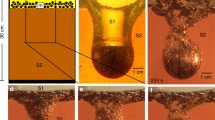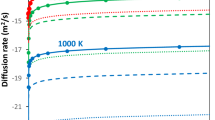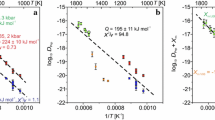Abstract
We have calculated the diffusivity of aluminium in periclase, MgO, under pressures relevant to deep planetary interiors from first principles. We reconcile differences between experimental migration enthalpies and those obtained with previous theoretical studies by finding a lower energy saddle point for the aluminium atom migration. Previous studies did not recognise a bifurcation at the saddle point. We also explain differences between experimental and theoretical binding enthalpies of an aluminium with a magnesium vacancy. We find that binding enthalpies continuously increase with decreasing aluminium concentrations, such that the difference between experimental and theoretical binding energies can be attributed to differing concentrations. We also find that binding energies increase with pressure as the permittivity decreases. Aluminium therefore not only causes extrinsic vacancy formation but also binds some of them, effectively removing them for magnesium diffusion. We discuss the implications for how other 3+ ions affect diffusion in oxides and silicates.






Similar content being viewed by others
References
Alfè D (2009) PHON: a program to calculate phonons using the small displacement method. Comput Phys Commun 180:2622–2633
Alfè D, Gillan MJ (2005) The Shottky defect formation energy in MgO calculated by diffusion Monte Carlo. Phys Rev B 71(220101):1–3
Ammann MW, Brodholt JP, Dobson DP (2010a) Simulating diffusion. Rev Mineral Geochem: Theor Comput Methods Miner Phys: Appl Geophys 71:201–224
Ammann MW, Brodholt JP, Wookey J, Dobson DP (2010b) First-principles constraints on diffusion in lower-mantle minerals and a weak \( D^{\prime \prime}\) layer. Nature 466:462–465
Ammann MW, Brodholt JP, Dobson DP (2011) Ferrous iron diffusion in ferro-periclase across the spin transition. Earth Planet Sci Lett 302:393–402
Badro J, Fiquet G, Guyot F, Rueff JP, Struzhkin VV, Vankó G, Monaco G (2003) Iron partitioning in Earth’s mantle: towards a deep lower mantle discontinuity. Science 300:789–791
Baroni S, Giannozzi P, Testa A (1987) Green’s-function approach to linear response in solids. Phys Rev Lett 58:1861–1864
Blöchl PE (1994) Projector augmented-wave method. Phys Rev B 50:17953–17979
Carroll JCG, Corish J, Henderson B, Mackrodt WC (1988) Theoretical study of the defect distribution of trivalent cation impurities in MgO. J Mater Sci 23:2824–2836
Castleton CWM, Höglund A, Mirbt S (2009) Density functional theory calculations of defect energies using supercells. Model Simul Mater Sci Eng 17(084003)1–21
Colbourne EA, Mackrodt WC (1982) The influence of impurities on the migration energy of cation vacancies in MgO. Ceram Int 8:90–92
De Vita A, Gillan MJ, Lin JS, Payne MC, Stich I, Clarke LJ (1992) Defect energetics in MgO treated by first-principles methods. Phys Rev B 46:12964–12973
Gilbert CA, Kenny SD, Smith R, Sanville E (2007) Ab initio study of point defects in magnesium oxide. Phys Rev B 76(184103):1–10
Gourdin WH, Kingery WD (1979) The defect structure of MgO containing trivalent cation solutes: shell model calculations. J Mater Sci 14:2053–2073
Gourdin WH, Kingery WD, Driear J (1979) The defect structure of MgO containing trivalent cation solutes: the oxidation–reduction behaviour of iron. J Mater Sci 14:2074–2082
Henkelman G, Uberuaga BP, Jónsson H (2000) A climbing image nudged elastic band method for finding saddle points and minimum energy paths. J Chem Phys 113:9901–9904
Hirsch LM, Shankland TJ (1991) Equilibrium point defect concentrations in MgO: understanding the mechanisms of conduction and diffusion and the role of Fe impurities. J Geophys Res 96:385–403
Howard RE, Manning JR (1967) Kinetics of solute-enhanced diffusion in dilute face-centered cubic alloys. Phys Rev 154:561–568
Karato S, Zhang S, Wenk HR (1995) Superplasticity in Earth’s lower mantle: evidence from seismic anisotropy and rock physics. Science 270:458–461
Karki BB, Khanduja G (2006) Vacancy defects in MgO at high pressure. Am Mineral 91:511–516
Kresse G, Furthmüller J (1996) Efficiency of ab-initio total energy calculations for metals and semiconductors using a plane-wave basis set. Comput Mat Sci 6:15–50
Kresse G, Hafner J (1993) Ab initio molecular dynamics for liquid metals. Phys Rev B 47:558–561
Kresse G, Joubert J (1999) From ultrasoft pseudopotentials to the projector augmented wave method. Phys Rev B 59:1758–1775
Lany S, Zunger A (2009) Accurate prediction of defect properties in density functional supercell calculations. Model Simul Mater Sci Eng 17(084002):1–14
Leslie M, Gillan MJ (1985) The energy and elastic dipole tensor of defects in ionic crystal calculated by the supercell method. J Phys C: Solid State Phys 18:973–982
Lidiard AB (1955) Impurity diffusion in crystals (mainly ionic crystals with the sodium chloride structure). Philos Mag 46:1218–1237
Lidiard AB (1960) The influence of solutes on self-diffusion in metals. Philos Mag 5:1171–1180
Makov G, Payne MC (1995) Periodic boundary conditions in ab initio calculations. Phys Rev B 51:4014–4022
Manning J (1964) Correlation factors for impurity diffusion. BCC diamond, and FCC. Phys Rev 136:A1758–A1766
Monkhorst HJ, Pack J (1976) Special points for Brillouin-zone integrations. Phys Rev B 23:5048–5192
Mulroue J, Duffy DM (2001) An ab initio study of the effect of charge localization on oxygen defect formation and migration energies in magnesium oxide. Proc R Soc A 467:2054–2065
Murakami M, Hirose K, Sata N, Ohishi Y (2005) Post-perovskite phase transition and mineral chemistry in the pyrolitic lowermost mantle. Geophys Res Lett 32(L03304):1–4
Oganov AR, Gillan MJ, Price GD (2003) Ab initio lattice dynamics and structural stability of MgO. J Chem Phys 118:10174–10182
Otsuka K, McCammon CA, Karato S (2010) Tetrahedral occupancy of ferric iron in (Mg, Fe) O: implications for point defects in the Earth’s lower mantle. Phys Earth Planet Int 180:179–188
Perdew JP, Wang Y (1992) Accurate and simple analytic representation of the electron–gas correlation energy. Phys Rev B 45:13244–13249
Perdew JP, Zunger A (1981) Self-interaction correction to density-functional approximations for many-electron systems. Phys Rev B 23:5048–5079
Perkins RA, Rapp RA (1973) The concentration-dependent diffusion of chromium in nickel oxide. Metall Trans 4:193–205
Sangster MJL, Stoneham AM (1984) Calculation of absolute diffusion rates in oxides. J Phys C: Solid State Phys 17:6093–6104
Shannon RD (1976) Revised effective ionic radii and systematic studies of interatomic distances in halides and chalcogenides. Acta Cryst A 32:751–767
Stacey FD, Davis PM (2004) High pressure equations of state with applications to the lower mantle and core. Phys Earth Planet Inter 142:137–184
Sun T, AllenDGP B andStahnke, Jacobsen SD, Homes CC (2008) Infrared properties of ferropericlase Mg1−x Fe x O: experiment and theory. Phys Rev B 77(134303):1–7
Van Orman JA, Fei Y, Hauri EH, Wang J (2003) Diffusion in MgO at high pressures: constraints on deformation mechanisms and chemical transport at the core–mantle-boundary. Geophys Res Lett 30:28–14
Van Orman JA, Li C, Crispin KL (2009) Aluminum diffusion and Al-vacancy association in periclase. Phys Earth Planet Inter 172:34–42
Vineyard GH (1957) Frequency factors and isotope effects in solid state rate processes. J Phys Chem Solids 3:121–127
Weeks RA, Gastineau J, Sonder E (1980) Distribution of Fe3+ in iron-doped MgO single crystals. Phys State Solids 61:265–274
Wu X, Vanderbilt D, Hamann DR (2005) Systematic treatment of displacements, strains, and electric fields in density-functional perturbation theory. Phys Rev B 72(035105):1–13
Acknowledgments
The authors acknowledge the use of UCL Research Computing facilities of Legion and of HECToR, the UK’s national high-performance computing service, which is provided by UoE HPCx Ltd at the University of Edinburgh, Cray Inc and NAG Ltd., and funded by the Office of Science and Technology through EPSRC’s High End Computing Programme.
Author information
Authors and Affiliations
Corresponding author
Rights and permissions
About this article
Cite this article
Ammann, M.W., Brodholt, J.P. & Dobson, D.P. Diffusion of aluminium in MgO from first principles. Phys Chem Minerals 39, 503–514 (2012). https://doi.org/10.1007/s00269-012-0506-z
Received:
Accepted:
Published:
Issue Date:
DOI: https://doi.org/10.1007/s00269-012-0506-z




